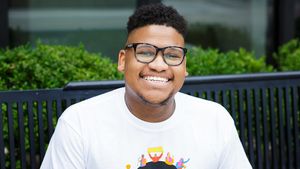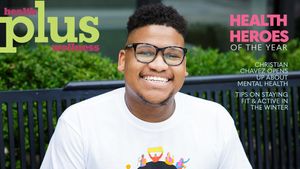LGBTQ+ youth have hope for their futures, but queer youth of color seemingly have less faith than their white peers.
The majority of young LGBTQ+ people (64 percent) reported believing there is a high chance they will live to age 35, while just over one-third (36 percent) believed their chances are low, according to a new survey from the Trevor Project of 28,524 LGBTQ+ young people ages 13-24.
This is due to a number of factors, explains Steven Hobaica, a research scientist at the Trevor Project who holds a doctorate in clinical psychology. That includes strong social networks, access to health care, and "life purpose."
"LGBTQ+ young people who believed they had a high chance of living past 35 were also more likely to report having high levels of life purpose, which shows us that developing one's life purpose may be crucial in suicide prevention," he told The Advocate via email.
"Additionally, it is possible that these youth with high levels of life purpose may have had access to more protective factors that encouraged the development of their life purpose, such as accepting and supportive parents, friends, and teachers, access to affirming schools or communities, or access to needed health care including LGBTQ+ affirming therapy or gender-affirming care."
While the majority of LGBTQ+ youth reported some sense of optimism, one-third responding negatively is still a troublesome trend. Additionally, LGBTQ+ young people's expectations shift across demographics. Those ages 13 to 17, transgender and nonbinary youth, youth of color, and multisexual youth (e.g., bisexual, pansexual, queer) were all more likely to report mental health and life expectancy concerns than their peers.
"We found that white LGBTQ+ young people were more likely to endorse a higher chance of living past 35 compared to their peers of color, possibly due to generally having less stressful life experiences," Hobaica explains. "It is well documented that youth who hold multiple marginalized identities, such as LGBTQ+ youth of color, report higher rates of both stressful life events and mental health problems than their White LGBTQ+ peers, which may help explain these findings."
He adds that these expectations could have also been impacted by recent events, such as "the COVID-19 pandemic, public policy changes, or having a lack of access to needed health care."
Those who reported perceived low life expectancy were more likely than their peers to also report anxiety (82 percent vs. 58 percent), nearly twice as likely to report depression (77 percent vs. 40 percent) and self-harm (77 percent vs. 41 percent), nearly three times as likely to report suicide consideration (69 percent vs. 24 percent), and nearly five times as likely to report having attempted suicide (28 percent vs. 6 percent).
Hobaica added that "systemic policy change is needed in order to address the mental health of LGBTQ+ youth." This includes policies such as "the banning of conversion therapy, improving health care access and educational environments, and creating protections against discrimination." These policies must also be "intersectional," he noted, to address the "unique challenges faced by individuals who navigate multiple marginalized identities."
"By doing so, all members of the community can be properly represented and included when policy is being shifted to be more affirming of LGBTQ+ youth," he said.
If you or someone you know needs mental health resources and support, The Trevor Project is available 24/7 by call, text, or chat with services specific to LGBTQ+ people and youth. The 988 Suicide & Crisis Lifeline or 988lifeline.org is also available 24/7 with free and confidential services.
The Trevor Project report first stated that 58 percent of LGBTQ+ young people reported life expectancy above age 35, and 34 percent reported life expectancy below 35. They have since corrected that data. This article has been updated to reflect the new numbers.



















































































